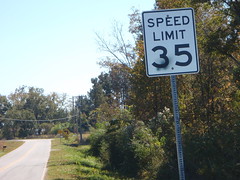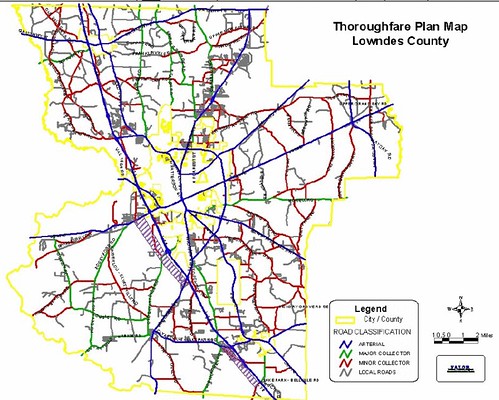“from a traffic safety perspective, the modern commercial arterial is a perfect storm of bad planning and design. These roads are designed to support high operating speeds, making it difficult for drivers to stop quickly to avoid a crash, and the presence of commercial and retail uses on these roads means that drivers will routinely need to stop quickly in order to avoid crashing into pedestrians, bicyclists, and especially vehicles turning in and out of driveways.”The 2006 article, Safe Urban Form: Revisiting the Relationship Between Community Design and Traffic Safety, by Eric Dumbaugh and Robert Rae, notes: Continue reading
Tag Archives: Safety
Trees make streets safer
 Beta New Urban Network reported 1 September 2006 that
Research: trees make streets safer, not deadlier:
Beta New Urban Network reported 1 September 2006 that
Research: trees make streets safer, not deadlier:
Proposals for planting rows of trees along the roads — a traditional technique for shaping pleasing public spaces — are often opposed by transportation engineers, who contend that a wide travel corridor, free of obstacles, is needed to protect the lives of errant motorists.The study asks a key question: Continue readingIncreasingly, however, the engineers’ beliefs about safety are being subjected to empirical study and are being found incorrect. Eric Dumbaugh, an assistant professor of transportation at Texas A&M, threw down the gauntlet with a long, carefully argued article, ”Safe Streets, Livable Streets,” in the Summer 2005 issue of the Journal of the American Planning Association. A follow-up article by Dumbaugh, in the 2006 edition of Transportation Research Record, will present further evidence that safe urban roadsides are not what the traffic-engineering establishment thinks they are.
Though engineers generally assert that wide clear areas safeguard motorists who run off the roads, Dumbaugh looked at accident records and found that, on the contrary, wide-open corridors encourage motorists to speed, bringing on more crashes. By contrast, tree-lined roadways cause motorists to slow down and drive more carefully, Dumbaugh says.
Dumbaugh examined crash statistics and found that tree-lined streets experience fewer accidents than do “forgiving roadsides” — those that have been kept free of large, inflexible objects. He points to “a growing body of evidence suggesting that the inclusion of trees and other streetscape features in the roadside environment may actually reduce crashes and injuries on urban roadways.”
Gretchen and Paige on WCTV about Quarterman Road
Quarterman Road in Hahira was paved within the last year.How did WCTV hear about this? They saw our neighbor Carolyn on YouTube: Continue readingSome people who live there say people drive faster than the posted 35 miles per hour limit.
The Georgia Department of Transportation says this type of paving is safe for up to 45 miles per hour.
Lowndes County agreed to lower the speed limit to 35 miles per hour after they heard concerns from residents.
Since GDOT says the 45 mile per hour is acceptable, a posted speed limit of 35 can’t be enforced without approval.
Residents just want something done.
“We had drag racers out here a few weeks ago, two corvettes speed racing side by side up and down the road,” said Gretchen Quarterman who lives on the road. “It’s a neighborhood, we have 30 families that live on this road, they have small children.”
“Your streets are designed to kill people.”
 Roads that are designed to kill,
By Mark Rosenberg,
August 18, 2009:
Roads that are designed to kill,
By Mark Rosenberg,
August 18, 2009:
They said the speed limit should be 30 kilometers per hour (about 18.6 miles per hour) or less if we wanted pedestrians to have much of a chance of surviving.That’s what people in Sweden say. In their country, roads are actually designed to be safe. Unlike ours:
“This is where you live? This is your neighborhood? Your streets are designed to kill people.’’It’s not hard to find descriptions of Sweden’s Vision Zero for no road deaths:
Vehicle speed is the most important regulating factor for safe road traffic.Hm, so slower is safer.
Quarterman Road (like many other rural roads in Lowndes County) is a local neighborhood road, with tractors, bicycles, dogs, deer, and mothers rolling babies in strollers. According to Claes Tingvall, Director of Traffic Safety, Swedish Road Administration:
The idea of ”shared space” between pedestrians and vehicles has been trialed successfully in Gothenburg and other cities, as long as the environment has been redesigned for slow traffic.And a budget-conscious county may be interested that he also says this:
The new safety principle, to control kinetic energy, is by itself cheaper than accident prevention. And once that investment is made it produces benefits every year.Not to mention the benefit of fewer traffic accidents, injuries, and deaths.
Neighborhood Watches Good in Bad Economy
 CNN has an interesting interactive graphic about house safety:
CNN has an interesting interactive graphic about house safety:
When the economy goes down, crime often rises, says Al Lenhardt, CEO and president of the National Crime Prevention Council.Lenhardt sums it up:
They reduce crime and they reduce the fear of crime …. It’s the golden rule — watching out for others.Although it’s not well known, Lowndes County, Georgia does have a neighborhood watch program (see picture of a sign), as do some of the cities in it, including I think Valdosta and Hahira.
A Local Rural Road is Not a Collector
The first map below is from the Lowndes County Thoroughfare Plan dated January 28, 2003; this is the version currently on the county’s public web pages. It plainly shows Quarterman Road (near the top center) as a local road.
The Georgia Department of Transportation (GDOT) told me that it is possible to classify parts of a road differently, especially when the major source of traffic is (in GDOT’s example) a subdivision that is located closer to one end. This is confirmed by the second map, from the South Georgia Regional Development Center (SGRDC), Continue reading
Slower is Safer
 Even the already-paved part of Quarterman Road currently has a posted
speed limit of 35 MPH (shown at right). That’s the part the subdivision uses to go to work.
I have never heard anyone complain that speed limit is too low. Why, then,
would anyone need a faster speed limit on the rest of Quarterman Road,
which has less traffic?
Even the already-paved part of Quarterman Road currently has a posted
speed limit of 35 MPH (shown at right). That’s the part the subdivision uses to go to work.
I have never heard anyone complain that speed limit is too low. Why, then,
would anyone need a faster speed limit on the rest of Quarterman Road,
which has less traffic?
As mentioned in the previous post, I understand that county staff and commissioners are concerned about their certifications, liability, and even, as we heard at the public commission meeting, about getting telephone calls in the night. Here is evidence that turning Quarterman Road into a wider, faster, collector road would not reduce any of those risks to county staff or commissioners, rather, by decreasing the safety of the road and its residents, such changes would increase risks to staff and commissioners.
First note that AASHTO itself carefully distinguishes residential neighborhoods from highways: Continue reading
Wider is Not Safer
 Wider is not safer. Wider encourages drivers to go faster, which causes
more accidents. On a highway, where the point is to go faster, wider is
a good idea. In a neighborhood such as Quarterman Road
with small children catching
the schoolbus, teenagers visiting among themselves, bicyclists, farm
equipment, dogs, and horses, faster is less safe, and wider is less safe.
Wider is not safer. Wider encourages drivers to go faster, which causes
more accidents. On a highway, where the point is to go faster, wider is
a good idea. In a neighborhood such as Quarterman Road
with small children catching
the schoolbus, teenagers visiting among themselves, bicyclists, farm
equipment, dogs, and horses, faster is less safe, and wider is less safe.
“Over approximately the last 60 years, the design of streets has gone from those designed to accommodate a mix of transportation options, to that designed to carry the maximum number of automobiles as fast as possible. However, not all street types serve the same purposes. Highways, freeways and the Interstate Highway System are designed for the sole purpose of maximizing the speed of travel and convenience of automobile use. Residential design must be different to accommodate the character of the street. Unfortunately, streets in residential neighborhoods are now being designed using similar standards, yielding a situation that is not only inconvenient and inefficient, but also very dangerous. Streets must be designed to maximize overall safety.Now quoting from that last cited source: Continue reading“Municipal decision makers need to take responsibility for the overall safety of the streets in their community. According to the House Committee on Public Works (U.S. Congress) (as found in A Policy on Geometric Design of Highways and Streets: 2001 by AASHTO):”
